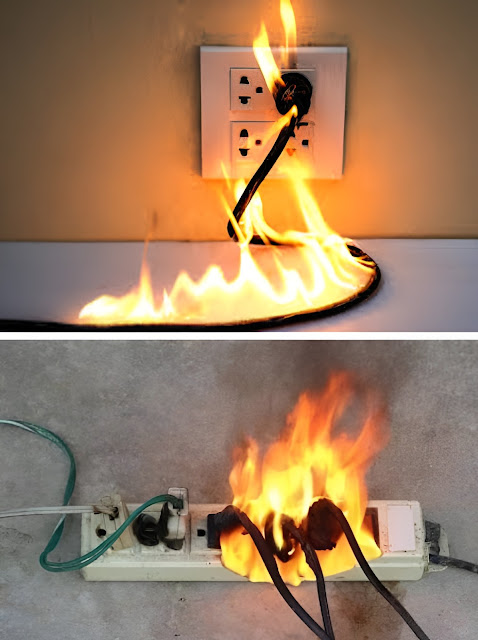Do Not Connect These 9 Things to a Power Strip! –

Power strips are incredibly convenient tools, giving us the ability to plug multiple devices into one outlet. However, not all devices are meant to be plugged into a power strip. Overloading a power strip or plugging in high-power devices can lead to overheating, tripped breakers, and even fire hazards. Here are nine things you should never connect to a power strip to keep your home safe.
1. Refrigerators and Freezers
Refrigerators and freezers draw a lot of power and run continuously to keep food cold. They require a dedicated circuit because of their high wattage needs and frequent cycling. Plugging a refrigerator or freezer into a power strip could overload the strip, potentially causing a short circuit or power failure, which may spoil your food and create a fire hazard.
2. Microwaves
Microwaves use a significant amount of power—typically around 1,000 watts or more—making them unsuitable for power strips. Due to their high power demands, microwaves should be plugged directly into a wall outlet to avoid overloading the strip or tripping the circuit.
3. Space Heaters
Space heaters, especially electric ones, are known for their high power consumption. Many fires have been traced back to improperly plugged-in space heaters. Plugging a space heater into a power strip can overheat the strip, which could lead to melting, sparking, or even a fire. Always plug space heaters directly into a wall outlet.
4. Air Conditioners
Like space heaters, air conditioners are high-power devices that should never be connected to a power strip. Air conditioners require a large amount of electricity, especially when the compressor kicks in, which could easily overwhelm a power strip. Connecting an air conditioner to a power strip risks overheating and damaging both the strip and the unit.
5. Toasters and Other Kitchen Appliances
Kitchen appliances such as toasters, coffee makers, and blenders use a significant amount of electricity. They are typically designed to be plugged directly into a wall outlet rather than a power strip, which may not be able to handle the sudden power surges that these appliances cause. Using them with a power strip can lead to overheating or even electrical fires.

6. Hair Dryers and Other Beauty Tools
Beauty tools like hair dryers, straighteners, and curling irons consume a lot of power and often generate heat. These should never be plugged into a power strip, as they can easily overload it. Hair dryers, in particular, draw a large current that can cause the power strip to overheat, increasing the risk of fire.
7. Sump Pumps
Sump pumps are essential for keeping basements dry during heavy rains, and they are critical devices that should never be plugged into a power strip. They require a stable, high-power connection to function correctly. If a sump pump loses power due to an overloaded power strip, it could lead to significant flooding and costly water damage.
8. Portable Dishwashers and Washing Machines
Large appliances like portable dishwashers and washing machines need more power than a power strip can safely provide. These appliances cycle on and off, drawing high amounts of current, which can quickly overload a power strip. Plug them directly into a wall outlet to ensure their safe and efficient operation.
9. High-Powered Electronics Like TVs and Computers
While TVs and computers may not seem as risky as other items on this list, they are still better off plugged directly into a wall outlet or, ideally, a surge protector. Computers, TVs, and gaming consoles can be sensitive to power fluctuations, and a power strip does not always offer the level of surge protection they require. Using a dedicated surge protector or UPS (uninterruptible power supply) can help protect these valuable electronics.
Why Is Overloading a Power Strip Dangerous?
Power strips are designed to handle a certain amount of electrical load, usually around 1,800 watts. When devices that draw a lot of power are plugged into them, they can exceed this limit. Overloaded power strips are at high risk of overheating, which could melt the plastic casing and wiring, leading to sparks, electrical shorts, or even fires.
Cheap or poorly made power strips may not have proper internal safety mechanisms to handle the stress of multiple high-power devices, increasing the likelihood of failure.
Tips for Using Power Strips Safely Use a Surge Protector: Invest in a power strip with built-in surge protection to protect your devices from sudden power surges. Surge protectors are a safer option, especially for valuable electronics. Limit the Number of Devices: Avoid plugging in too many devices at once. Be mindful of the power draw of each device, and unplug items when they’re not in use. Inspect Regularly: Check your power strips regularly for signs of damage, such as frayed cords, melted plastic, or scorched marks. Replace any damaged power strips immediately. Know Your Power Needs: Familiarize yourself with the power requirements of each appliance. Anything that produces heat or has a motor should generally be plugged directly into a wall outlet. Use Circuit Breakers: Some power strips come with a built-in circuit breaker that will trip if the power draw is too high, cutting off the current and preventing overheating. Final Thoughts
Power strips are a convenient way to increase the number of outlets in your home, but they aren’t designed to handle everything. Heavy-duty or high-wattage appliances should always be plugged directly into wall outlets to ensure safety and efficiency. By being mindful of what you plug into your power strips, you can avoid overloading them and reduce the risk of fire hazards in your home.



